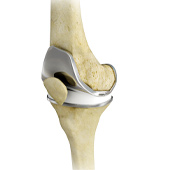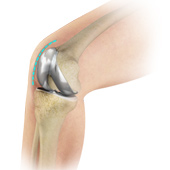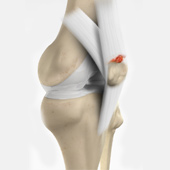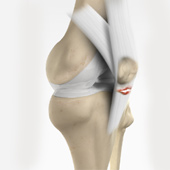Knee Procedures
- Anatomy
- Conditions
- Procedures
Am I a Candidate for Knee Surgery?
Arthritis of the knee can cause pain and stiffness, making regular activities such as walking and bending difficult. As arthritis progresses, conservative treatments tend to lose their efficacy and more definitive treatment should be considered. Knee replacement surgery involves replacing worn or damaged joints with implants to reduce pain and improve movement. It provides excellent results for many and is usually performed on those above 60 but may also benefit young patients with certain conditions.
After Knee Replacement
After knee replacement surgery, once the anesthesia wears off, you will start to experience pain, for which your doctor will prescribe medication. You may have to remain in the hospital for a few days depending on your progress and overall health. Remember to get plenty of rest during this initial phase. Your surgical wounds should be monitored for swelling, inflammation and other changes and frequent dressing changes are performed.
Total Knee Replacement
Total knee replacement, also called total knee arthroplasty, is a surgical procedure in which the worn out or damaged surfaces of the knee joint are removed and replaced with artificial parts.
Minimally Invasive Knee Joint Replacement
Total knee replacement is a very successful surgical treatment for knee arthritis. Over the years, minimally invasive knee replacement surgical techniques have been developed to lessen tissue trauma and improve patient outcomes. This minimally invasive approach involves much smaller incisions than the usual 10-12 inch incisions used in the traditional knee replacement and spares the quadriceps muscle and tendon, which control bending of the knee, from being cut to access the knee joint.
Partial Knee Replacement
Unicompartmental knee replacement is a minimally invasive surgery in which only the damaged compartment of the knee is replaced with an implant. It is also called a partial knee replacement.
Revision Knee Replacement
Revision knee replacement surgery involves replacing a part or all your previous knee prosthesis with a new prosthesis. Although total knee replacement surgery is successful, sometimes the procedure can fail due to various reasons and may require a second revision surgery.
Painful or Failed Total Knee Replacement
Total knee replacement is a surgery employed to resurface knee joints damaged by arthritis, degeneration, or injury and replacing the damaged joints with a prosthesis (an artificial knee joint).
Knee Arthroscopy
Knee arthroscopy is a common surgical procedure performed using an arthroscope, a viewing instrument, to diagnose or treat a knee problem. It is a relatively safe procedure and you will usually be discharged from the hospital on the same day of surgery.
Partial Meniscectomy
Partial meniscectomy is a surgical procedure to remove the torn portion of the meniscus from the knee joint.
Periprosthetic Knee Fracture Fixation
Periprosthetic knee fracture fixation is a procedure performed to stabilize a fracture that occurs in the bone present around a knee prosthesis. The fracture may involve the lower part of the thighbone (femur), the kneecap (patella) or the upper part of the shinbone (tibia).
ORIF of the Knee Fracture
ORIF refers to open reduction and internal fixation. It is a surgical procedure employed for the treatment of a fracture not amenable to non-surgical conservative treatment.
Quadriceps Tendon Repair
Quadriceps tendon is a thick tissue located at the top of the kneecap. The quadriceps tendon works together with the quadriceps muscles to allow us to straighten our leg. The quadriceps muscles are the muscles located in front of the thigh.
Patellar Tendon Repair
Patella tendon rupture is the rupture of the tendon that connects the patella (kneecap) to the top portion of the tibia (shinbone). The patellar tendon works together with the quadriceps muscle and the quadriceps tendon to allow your knee to straighten out.













